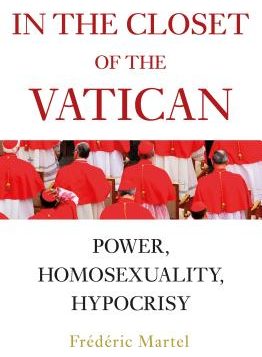 In the Closet of the Vatican: Power, Homosexuality, Hypocrisy
In the Closet of the Vatican: Power, Homosexuality, Hypocrisy
by Frédéric Martel
Translated by Shaun Whiteside
Bloomsbury. 555 pages, $30.
THIS BIG BOOK—550 large text-packed pages—is more than just the print presentation of one journalist’s research. Frédéric Martel’s In the Closet of the Vatican is a product of hundreds of interviews and investigative research carried out by the author and his eighty-member staff over several years in thirty countries around the globe. Despite the misleading English title—the French original is the less specific Sodoma—this is not just an exposé of homosexuality in the Vatican, where it is evidently widespread.
Instead, the book is an examination of how, since the 1970s, the issue of homosexuality has come to preoccupy the largely gay if often closeted upper hierarchy of the Catholic church throughout the West, and how these church leaders have, to avoid scandal, created policies that support not just homophobia and hypocrisy but also corruption, leaving clerical abuse of minors, even when egregious, almost untouched.
Martel remarks halfway through this tome that he is less concerned with “outing living priests than with describing a system.” A gay man himself and no longer Catholic, he does not object to clergy having same-sex relationships. Rather, he has organized this extensive research to expose the repressive, “inhuman,” and often morally indifferent organizational structures that have been operating for the last half-century in the Vatican and much of the Catholic church in Europe and North and South America. (For Martel, things have improved since the election of Francis I.)
Despite the misleading table of contents, Martel does not really approach his subject chronologically. Part I focuses on the omnipresence of homosexuals at all levels of the Vatican during the last half-century. It argues that the anti-gay rhetoric produced during the pontificates of John Paul II and Benedict XVI was the result of some of these gay or gay-leaning prelates’ internalized homophobia and their ever more desperate attempts to deny this significant homosexual presence to the outside world. This led to a condemnation of condoms as a way to fight the spread of AIDS and the Church’s war on gay marriage and civil unions. The denial figured prominently in the Church’s conscious and repeated refusal to fight or even acknowledge widespread clerical sexual abuse of minors.

The remainder of the book demonstrates the homophobic hypocrisy, corruption, and sometimes downright criminal behavior of certain highly placed prelates around the world, some of whom ended up in Rome. For the curious, Martel also examines rumors about the possible homosexuality of John Paul II and Benedict XVI, but offers no concrete evidence.
The epilogue comes out of no-where. In it, Martel speculates on how this institution of gay men living together with other gay men has created “an unexpected place of experimentation: new ways of living as a couple are constructed there; new emotional relationships are tried out; new models of the family of the future are explored.” After 530 pages devoted to showing how the Catholic Church, while it provides shelter for gay men in a world that does not ask why they aren’t involved with women, does so at the price of forcing them to live in the closet under constant fear of exposure and expulsion, these last twenty pages seem incongruously upbeat.
The real problem with this book, however, is not its content but its user-unfriendly presentation. Despite its formidable length and wide-ranging subject matter, there’s no index, and the chapter headings are often uninformative or insufficient. As a result, only those willing to swallow this volume in its entirety will be able to benefit from the mammoth work undertaken by Martel and his staff on these important issues. I find it strange that the publishers, after having invested all the money it must have taken to support such an undertaking, would have skimped on these amenities. There is much that deserves to be known in this work. It is a shame to limit it to only those with the leisure and persistence to read it from cover to cover like a long novel, for which it is unlikely to be mistaken. Perhaps Bloomsbury could put an index on the book’s website.
Richard M. Berrong is the author of the recently published biography Pierre Loti(Critical Lives).






